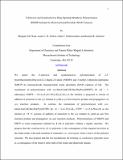| dc.contributor.author | Flook, Margaret M. | |
| dc.contributor.author | Gerber, Laura C. H. | |
| dc.contributor.author | Debelouchina, Galia Tzvetanova | |
| dc.contributor.author | Schrock, Richard Royce | |
| dc.date.accessioned | 2012-03-02T19:44:53Z | |
| dc.date.available | 2012-03-02T19:44:53Z | |
| dc.date.issued | 2010-08 | |
| dc.date.submitted | 2010-06 | |
| dc.identifier.issn | 0024-9297 | |
| dc.identifier.issn | 1520-5835 | |
| dc.identifier.uri | http://hdl.handle.net/1721.1/69579 | |
| dc.description.abstract | We report the Z-selective and syndioselective polymerization of 2,3-bis(trifluoromethyl)bicyclo[2.2.1]hepta-2,5-diene (NBDF6) and 3-methyl-3-phenylcyclopropene (MPCP) by monoaryloxide monopyrrolide imido alkylidene (MAP) catalysts of Mo. The mechanism of polymerization with syn-Mo(NAd)(CHCMe2Ph)(Pyr)(OHIPT) (1; Ad = 1-adamantyl, OHIPT = O-2,6-(2,4,6-i-Pr3C6H2)2C6H3) as the initiator is proposed to consist of addition of monomer to the syn initiator to yield a syn first insertion product and propagation via syn insertion products. In contrast, the mechanism of polymerization with syn-Mo(NAr)(CHCMe2Ph)(Pyr)(OTPP) (4; Ar = 2,6-i-Pr2C6H3, OTPP = 2,3,5,6-Ph4C6H) as the initiator at −78 °C consists of addition of monomer to the syn initiator to yield an anti first insertion product and propagation via anti insertion products. Polymerizations of NBDF6 and MPCP at room temperature initiated by 4 led to polymers without a regular structure. We propose that the syndiotacticity of cis polymers is the consequence of the required inversion at the metal center with each insertion of monomer, i.e., stereogenic metal control of the polymer structure. We also propose that the two mechanisms for forming cis,syndiotactic polymers arise as a consequence of the relative steric bulk of the imido and phenoxide ligands. | en_US |
| dc.description.sponsorship | United States. Army Research Office (Institute for Soldier Nanotechnologies, Contract No. DAAD-19-02-D-0002) | en_US |
| dc.description.sponsorship | United States. Dept. of Energy (DE-FG02-86ER13564) | en_US |
| dc.description.sponsorship | National Institutes of Health (U.S.) (GM066360) | en_US |
| dc.description.sponsorship | National Institutes of Health (U.S.) (EB002026) | en_US |
| dc.language.iso | en_US | |
| dc.publisher | American Chemical Society | en_US |
| dc.relation.isversionof | http://dx.doi.org/10.1021/ma101375v | en_US |
| dc.rights | Article is made available in accordance with the publisher's policy and may be subject to US copyright law. Please refer to the publisher's site for terms of use. | en_US |
| dc.source | Prof. Schrock via Erja Kajosalo | en_US |
| dc.title | Z-Selective and Syndioselective Ring-Opening Metathesis Polymerization (ROMP) Initiated by MonoAryloxidePyrrolide (MAP) Catalysts | en_US |
| dc.type | Article | en_US |
| dc.identifier.citation | Flook, Margaret M. et al. “Z-Selective and Syndioselective Ring-Opening Metathesis Polymerization (ROMP) Initiated by Monoaryloxidepyrrolide (MAP) Catalysts.” Macromolecules 43.18 (2010): 7515–7522. | en_US |
| dc.contributor.department | Massachusetts Institute of Technology. Department of Chemistry | en_US |
| dc.contributor.department | Francis Bitter Magnet Laboratory (Massachusetts Institute of Technology) | en_US |
| dc.contributor.approver | Schrock, Richard Royce | |
| dc.contributor.mitauthor | Schrock, Richard Royce | |
| dc.contributor.mitauthor | Flook, Margaret M. | |
| dc.contributor.mitauthor | Gerber, Laura C. H. | |
| dc.contributor.mitauthor | Debelouchina, Galia Tzvetanova | |
| dc.relation.journal | Macromolecules | en_US |
| dc.eprint.version | Author's final manuscript | en_US |
| dc.type.uri | http://purl.org/eprint/type/JournalArticle | en_US |
| eprint.status | http://purl.org/eprint/status/PeerReviewed | en_US |
| dspace.orderedauthors | Flook, Margaret M.; Gerber, Laura C. H.; Debelouchina, Galia T.; Schrock, Richard R. | en |
| dc.identifier.orcid | https://orcid.org/0000-0001-5827-3552 | |
| mit.license | PUBLISHER_POLICY | en_US |
| mit.metadata.status | Complete | |
